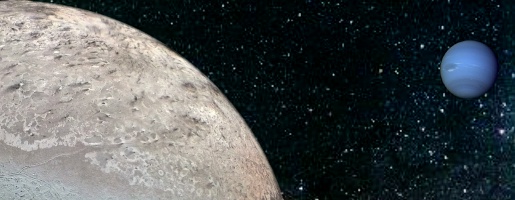 |
|||
|
A
montage of Voyager images of Triton and Neptune.
|
|||
| NEPTUNE - THE OUTER GAS GIANT | |||
| Neptune is the eighth planet outwards from the Sun, and the outermost gas giant. However, it is not always the eighth - for 20 years out of 248 it becomes the ninth, outermost planet of all, as tiny Pluto's orbital eccentricity brings Pluto closer to the Sun than Neptune. Neptune was the outermost planet between 21st January 1979 and 14th March 1999. | |||
| Neptune is too faint to be seen in the night sky with the naked eye, and hence this planet was not known to ancient civilisations. | |||
| Orbiting in the outer solar system | |||
| Neptune orbits the Sun at a distance of 4,497.81 million kilometres. The orbit is nearly a circle (eccentricity 0.01), and it takes Neptune over 164 years to complete one orbit. At this distance, the Sun looks like a bright star - the Neptunian system inhabits the dark and gloom of the outer Solar System. | |||
| Neptune is in an orbital resonance with Pluto - for every three revolutions about the Sun made by Neptune, Pluto makes exactly two. It is this resonance that prevents a collision between Neptune and Pluto. When the time comes for Pluto to cross Neptune's orbit, it is guaranteed that Neptune is in a safe place.Neptune's orbit. | |||
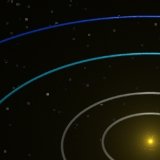 Neptune's orbit. |
|||
| Physical properties | |||
| Neptune is over 17 times more massive than Earth. In fact, Neptune's mass is greater then Uranus', making it the third most massive gas giant. With a diameter of 49,528 kilometres it is however smaller than Uranus. This means that Neptune is denser than Uranus (more mass in less volume), and therefore must be enriched in elements heavier than helium. | |||
| Neptune's escape velocity is 23.49 kilometres per second, over twice Earth's value. You have to travel twice as fast in order to escape Neptune's gravity. | |||
 Comparison between Earth and Neptune. |
|||
| Inside a Gas Giant | |||
| As with the other gas giants, the interior gets hotter, and the pressure higher, as you descend into the atmosphere. Most of the planet's volume is in fact atmosphere, but at the centre is possibly a core of rock and ice. This core accounts for at least 80% of Neptune's mass. As Neptune radiates 2.6 times as much energy as it actually receives from the Sun, so Neptune must have a heat source deep within the planet. | |||
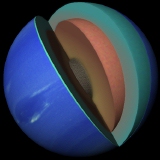 Cross-section through Neptune. |
|||
| More about the interior of Neptune | |||
| Magnetic field | |||
| Neptune has a magnetic field, resulting from dynamo action in the electrically conductive interior. The field is weaker than Uranus', and not as complex as that found at Jupiter. Unusually, the field is tipped 47o to the rotational axis, nor is it centred on the planet. | |||
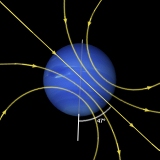 Neptune's magnetic field. |
|||
| More about Neptune's magnetic field | |||
| A Methane atmosphere | |||
| Neptune is a blue planet - not a sign of water, but of a small percentage of methane in the atmosphere. Methane absorbs red light, and reflects blue. Neptune's atmosphere is more dynamic than Uranus' - its winds are stronger than Jupiter's, and nine times stronger than winds found on Earth. Atmospheric features similar to Jupiter's Great Red Spot have been observed. The features have been named, but more recent observations have shown that the features have disappeared, to be replaced by others. | |||
 The blue coloration of Neptune. |
|||
| More about Neptune's atmosphere | |||
| Neptune's Ring System | |||
| Neptune has a ring system, but not as spectacular as Saturn's. The rings are very dark and faint. However, the rings contain arcs, or clumps, of material, an aspect of rings which had not been seen before. | |||
 Three of Neptune's rings are visible in this Voyager composite image. |
|||
| More about Neptune's ring system | |||
| Moons of Neptune | |||
| Neptune's eight moons are small and dark, with the exception of Triton, a large moon with active geysers, a complex terrain, and strange seasons. | |||
 The varying colours of Triton's surface. |
|||
| More about the moons of Neptune | |||
| Searching for Neptune | |||
| Neptune was not discovered by accident - it was searched for on the basis of mathematical predictions. Such predictions were a result of attempts to explain the orbital deviations of Uranus. The result was that two mathematicians, using the power of mathematics and the laws of Newton, correctly identified the position of a new planet which had previously been completely unknown, allowing its discovery on 23rd September 1846. | |||
| Subsequent to the discovery, there was some progress in exploration of the planet, but it was the arrival (at high speed) of the Voyager spacecraft in 1989 that for the first time revealed the full Neptunian system of planet, rings and moons. | |||
| More about the discovery and exploration of Neptune | |||
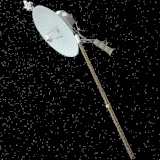 The Voyager spacecraft. |
|||
|
|
|||